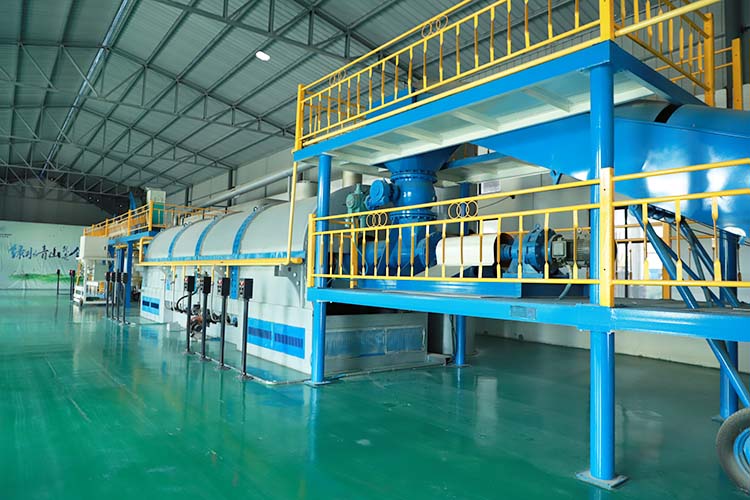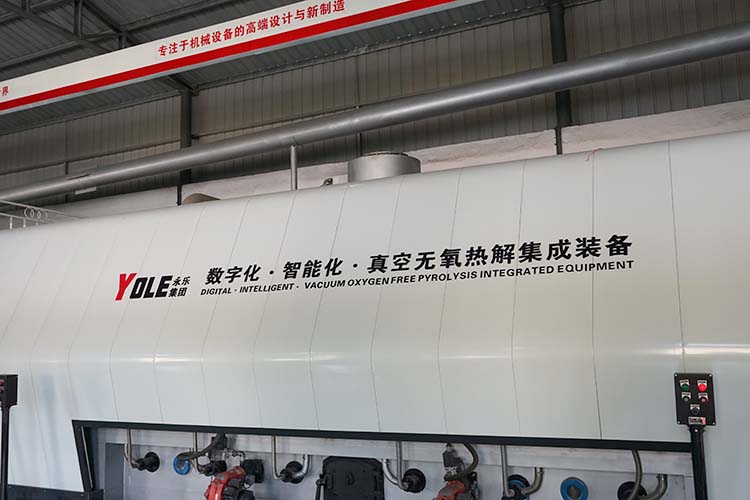In the field of urban and rural domestic waste treatment, a large-scale equipment plays a crucial role. It adopts the oxygen-free low-temperature continuous pyrolysis process for domestic waste, committing to harmless and resourceful treatment of urban and rural domestic waste, while achieving the goals of stabilization and reduction.
The core composition of the domestic waste treatment equipment revolves around the oxygen-free low-temperature continuous pyrolysis process. During the treatment, domestic waste is fed into the equipment and subjected to continuous pyrolysis reactions at low temperatures in an oxygen-free environment. This process environment avoids the harmful substances generated by high temperatures in traditional treatment methods, ensuring harmlessness from the source.

After pyrolysis treatment, domestic waste produces multiple products: inert solid carbon slag, pyrolysis fuel oil, and biogas. First, the inert solid carbon slag undergoes a sorting process after generation, during which some metals can be recycled and reused, while the remaining carbon slag has a wide range of comprehensive utilization directions, bringing good economic benefits. Pyrolysis fuel oil can be recycled for industrial fuel use or for the equipment's own needs, achieving circular utilization of resources. After dechlorination and purification, biogas becomes an energy source for the circular heating of the pyrolysis equipment. It is worth mentioning that it can meet more than 60% of the equipment's own energy self-sufficiency, greatly reducing dependence on external energy.
In terms of reduction effects, the domestic waste treatment equipment performs significantly. After treatment, the mass reduction rate of domestic waste is higher than 50%, and the volume reduction rate is higher than 90%. This means that a large amount of domestic waste is greatly reduced in volume and significantly lightened in mass after treatment, alleviating the pressure of waste 堆放 (stacking). At the same time, the domestic waste treatment equipment also makes outstanding contributions to environmental protection: each ton of domestic waste treated can reduce carbon emissions by 0.4-0.7 tons, contributing to improving environmental quality and achieving the carbon neutrality goal.

The composition of the domestic waste treatment equipment is closely centered around the pyrolysis process, with each link cooperating to form an efficient treatment system. From the input of waste to the progress of pyrolysis reactions and then to the collection and processing of products, every step is carefully designed to ensure the continuity and stability of the treatment process. The creation of an oxygen-free environment and the control of low-temperature conditions are key parts of the equipment's composition, providing a guarantee for the smooth progress of pyrolysis reactions and enabling full decomposition of domestic waste to produce valuable products.
In terms of resource utilization, the three products are reasonably processed and applied. The metal recycling and comprehensive utilization of solid carbon slag, the industrial and self-use of pyrolysis fuel oil, and the circular heating of biogas form a chain of circular resource utilization, which not only reduces the consumption of natural resources but also creates economic value. This method of converting domestic waste into usable resources reflects the advantages of domestic waste treatment equipment in resourceful treatment.

In summary, the domestic waste treatment equipment demonstrates significant advantages in harmless, resourceful, stable, and reduction treatment by virtue of its unique oxygen-free low-temperature continuous pyrolysis process composition. Its efficient treatment of domestic waste not only solves the problem of waste treatment but also achieves circular utilization of resources and environmental benefits, providing a reliable and effective solution for urban and rural domestic waste treatment.
Yongle Environmental Protection is mainly engaged in the research and development, production and sales of complete sets of technical equipment for organic solid waste disposal and comprehensive utilization. Production and manufacturing, domestic waste treatment equipment, tire pyrolysis equipment, medical waste disposal equipment, hazardous waste disposal equipment, and achieve efficient and comprehensive utilization of resources through independently developed low-temperature anaerobic pyrolysis equipment technology solutions.
Tags:Domestic waste treatment equipment helps environmental protection and carbon neutrality,Domestic waste disposal,YONGLE GROUP
 Latest news
Latest news


























